#Level Up Advanced 5e
Explore tagged Tumblr posts
Text
If you know anyone playing 5th Edition D&D and want them to switch to a new game, the level up Advanced 5e Core Rulebooks are on sale for a ridiculously low price.
0 notes
Text

"the word Camilla is engraved on its chest feathers"
IYKYK
#d&d#tabletop rpg#dnd#dnd5e#warlock patrons#5th edition dungeons & dragons#dungeons and dragons 5e#dungeons&dragons#dungeons & dragons#dungeons and dragons#dnd 5e#5e#d&d 5e#ttrpg#tabletop#rpg#gaming#magic items#Level Up 5E#Advanced 5E#Level Up: Advanced Fifth Edition#magic item
4 notes
·
View notes
Text
I was doing chores all day so I've only just had a chance to say it but
new video!
This is Pixel's Baboonmas session, and I got to play with Iris and Bri in it!
youtube
What's baboonmas you ask? Great question!
#ttrpg#dnd#rpg#d&d#youtube#dnd 5e#dungeons and dragons#d&d 5e#dnd5e#baboonmas#christmas#dungeons & dragons#advanced 5th edition#level up a5e#a5e#ttrpg actual play#dnd actual play#ttrpg podcast#dnd podcast#podcast#Youtube
0 notes
Note
With DND 5e being set up to cause DM burnout, can you give examples of tabletop systems that facilitate easy DMing? I love running a tabletop game but don't have the time to deal with 5e or homebrew anymore.
(With reference to this post here.)
This is an area where you're going to get a lot of bad advice, because there's no such thing as a tabletop RPG that's "easy to GM" in the abstract. Some systems make greater or lesser demands of the GM's time and skill, but the reason that Dungeons & Dragons has a massive GM burnout problem is a bit more subtle than that – indeed, D&D's GM burnout problem is considerably worse than that of many games whose procedures of play place much greater demands on the GM!
It boils down to the fact that games are opinionated. Even a very simple set of rules contains a vast number of baked-in assumptions about how the game ought to be played; in the case of tabletop RPGs, those baked-in assumptions include assumptions about what kinds of stories the game ought to be used to tell. The players of any given group, of course, also have assumptions – some explicit, many unexamined – about how the game's story ought to go. It's rare that these two sets of assumptions will perfectly agree.
Fortunately, perfect agreement isn't necessary, because tabletop RPGs aren't computer games, and it's always possible to tweak the outputs of the rules on the fly to better suit the desired narrative experience. In conventional one-GM-many-players games like D&D, this responsibility for monitoring and adjusting the outputs of the rules so that they're compatible with the narrative space the group wishes to explore falls principally on the GM.
Now, here's where the trouble starts: the larger the disconnect between the story the rules want to produce and the narrative space the group wants to explore, the more work the GM in a conventional one-GM-many-players context needs to do in order to close that gap. If the disconnect is large enough, the GM ends up spending practically all of their time babysitting the outputs of the rules, at the expense of literally every other facet of their responsibilities.
(Conversely, if that gap is large and isn't successfully closed, you can end up with a situation where engaging with the rules and engaging with the narrative become mutually exclusive activities. This is where we get daft ideas like "combat" and "roleplaying" being opposites – which is nonsense, of course, but it's persuasive nonsense if you've never experienced a game where the rules agree with you about what kind of story you should be telling.)
And here's where the problem with Dungeons & Dragons in particular arises. The rules of D&D aren't especially more opinionated than those of your average tabletop RPG; however, the game has developed a culture of play that's allergic to actually acknowledging this. There are several legs to this, including:
a text which makes claims about the game's supported modes of play that are far broader than what the rules in fact support;
a body of received wisdom about GMing best practices which consists mostly of advice on how to close the gap between the rules' assumptions and the players' expectations (but refuses to admit that this is what it's doing);
a player culture which has become increasingly hostile to players learning or knowing the rules, and positions any expectation that players should learn the rules as a form of "gatekeeping"; and
a propensity to treat a very high level of GMing skill as an entry-level expectation.
Taken together, all this produces a situation where, when the rules and the group disagree about how the game's story ought to go, the players don't experience it as a problem with the rules: they experience it as a problem with the GM. A lot of GMs even buy into this perception themselves, which is how you end up with GM advice forums overflowing with people telling novice GMs that they're morally bad people for being unprepared to tackle very advanced GMing challenges right from the jump.
(At this point, one may wonder: why on Earth would a game develop this sort of culture of play in the first place? Who benefits? Well, what we're looking at in practice is a culture of play which treats novice and casual GMs as a disposal resource whose purpose is to maximise the number of people playing Dungeons & Dragons. Follow the money!)
So, after all of that, the short answer is that there isn't a specific magic-bullet solution to avoiding D&D's GM burnout problem – or, at least, not one that operates at the level of the rules, because there's no particular thing that D&D as a system is doing "wrong" that produces this outcome; the problem operates almost entirely at the play culture level.
In practice, two things need to happen:
Placing a greater expectation on the players to learn and understand the game's rules; and
Selecting a system where the gap between the story the rules want to produce and the narrative space the group wants to explore is small.
It's that second one that's the real trick. In order to minimise that gap, we need to know what kind of narrative space your group wants to explore, and that might not be something you have a good answer to if you don't have good lines of communication with your players.
(As an aside, there's a good chance that we're going to see dipsticks cropping up in the notes insisting that their favourite system short-circuits this problem by being perfectly universal and having no baked-in narrative assumptions. These people are lying to you, and lending credence to the idea that there's any such thing as a universal RPG is a big part of how we got into this mess in the first place!)
2K notes
·
View notes
Text
"For the past nine months, I’ve heard from a fair number of people, including people close to me and people I’ve worked with, say they don’t want anything to do with Hasbro, WOTC, or D&D. Unfortunately, they’re piling all of 5e in there too. 5e isn’t D&D. Since its release into the Creative Commons by two different companies, 5e is now an open system supported by hundreds of publishers and, in some cases, with whole games built around it. 5e is now and forever an independent tabletop roleplaying platform not tied to any single company. If someone doesn’t like 5e as a system, that’s totally fine. Not every system is for everyone. I know many who love the tactical crunchiness and character customization of Pathfinder 2. I know many others who love the fast and furious grim dark fantasy of old-school games like Shadowdark, EZD6, and Old School Essentials. That’s cool. Likewise, if you’re happy with D&D and don’t want or need anything else, that’s cool too. Most D&D players probably never consider products outside of what WOTC produces for D&D. I definitely recommend looking at the many awesome D&D / 5e compatible products many other publishers have created. Here are ten notable products for 2022 and my YouTube video segment on favorite products of 2023, all from other publishers than WOTC. Check them out. If you enjoy 5e but you’re done with Hasbro or WOTC or the D&D brand, this message is for you. 5e isn’t D&D. You can enjoy the hell out of 5e without having to use any products or pay any money to Hasbro. There are several excellent alternative core books for 5e – my current favorite being EN Publishing’s Level Up Advanced 5e and more on the way like Kobold Press’s Tales of the Valiant. These companies pay no license fees to Hasbro. Their work is completely independent from D&D. In A5e’s case, they have their own system reference document they wrote and released under a Creative Commons license that’s significantly bigger than the 5.1 SRD. These systems and products are completely independent from Hasbro or WOTC or D&D. 5e's rules were built by designers, many of whom aren't at Hasbro anymore, based on principles that go back 50 years and two full company acquisitions ago. Yes, 5e came from the development of the 2014 version of D&D. 5e stands for “5th edition” and that’s the 5th edition of D&D, but that doesn’t matter now. Now, all of the mechanics are released under a Creative Commons license and, as mentioned, there’s a whole separate one you can use instead if you don’t want to use the one published by WOTC. If you love 5e, as I do, don’t throw it out just because you’re mad at one company publishing material for it. 5e is ours and I personally think it’s awesome. You’re not hurting anyone or supporting the wrong group by buing products for it, running it, and playing it. Game on."
(by SlyFlourish)
202 notes
·
View notes
Text
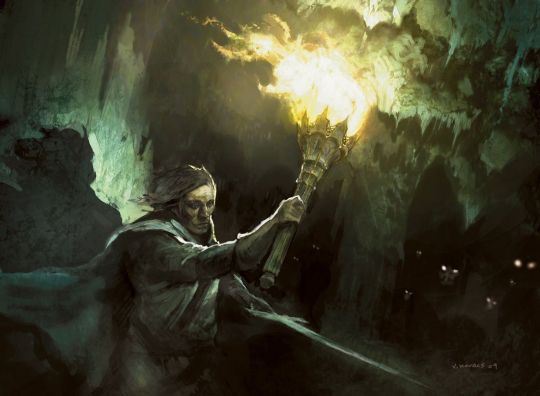
Tinkering With Torches, AKA how to use darkness as an actual mechanic
artist
Recently I've been running a lot of dungeons and nighttime combat in my games and as it turns out, I think illumination might be one of the most unterutilized and/or neglected mechanics in the game.
As a reminder for the class: 5e has three grades of illumination that matter: bright light, low light (where humans are at disadvantage on perception checks), and darkness (where humans are considered blind).
Thing is, darkvision or even a single torch trivializes those penalties: making the mechanic so easy to overcome most DMs I know don't even really bother with it any more. However, I think the core conceit of darkness is a REALLY useful thing to play with when we're engaging in the tactical combat side of gameplay: everyone wants their targets illuminated, but holding up a light to let your allies hit things makes you a target in return. It encourages repositioning, interaction with the environment, and even provides secondary objectives to combat.
With that in mind, here are a few tweaks that I'm going to be trying out:
Halving the distance of all forms of (player accessible) darkvision, and the illumination provided by all sources.
Being lightly obscured grants a +2 bonus to AC, and being heavily obscured grants +5, stacking with cover. Everyone should want their enemies lit up well. If you're playing with stress as a mechanic, I'd add these bonuses to the DC of saves vs fear and other effects to represent the safety that light provides. (This also fixes the weird rules interaction where two creatures who couldn't see eachother while fighting were just as accurate as two who could)
Reintroducing the idea of low light vision. 3.0/5 had the idea that there were sliding scales of being able to see in the dark, and I see no reason not to keep it. Rather than amending every character sheet that gets put in front of me, creatures that live underground and in deep shadow (dwarves, orcs, drow, shardar-kai) get to shift the light levels by 2, rather than by 1.
Stockpiling "Advanced Darkness" Spongebob memes for when I introduce this system for new players.
142 notes
·
View notes
Text
D&D 3e is an interesting edition in the context of D&D's greater history because it very much set D&D on its current course: it was the first edition of D&D to utilize the d20 system (where most actions are resolved via the roll of a d20 + modifiers trying to beat target numbers of ever-increasing difficulty) and it was the first edition of the game under Wizards of the Coast, and in many ways D&D 5e is specifically a throwback to D&D 3e. Sort of.
You see, the thing that sets D&D 3e apart from the other sundry versions of D&D, including its more similar than people are willing to acknowledge Wizards of the Coast sisters 4e and 5e, is that it's a rather complex game. This is something it has a reputation for, and it stands out as the most complex edition of D&D even when set against its other complicated siblings. Most discussions of said complexity, however, focus mostly on characters, which is understandable, because characters are the main way in which players will end up interacting with the game. And on a purely character-based level the game already is more complex than any other edition of D&D: players need to worry about feats (which are more plentiful than in 5e and require keeping track of more variables than in 4e), class features (some of which can be so complex as to mandate keeping track of a whole other character), spells, skills (which need to be bought in ranks: none of that "skilled" or "proficient" binary, skills are increased one point at a time), and whatever else. But there's more.
And that stuff is why I say that 5e is only "sort of" a successor to D&D 3e. It is a successor to D&D 3e in the sense that D&D 3e is the edition of the game it's most structurally similar to: characters consist of more or less the same parts as they did in D&D 3e, but there's often more gradation and fewer discrete choices between those parts. But when it comes to the actual philosophy of gameplay, D&D 5e is a lot more similar to 4e than most people are willing to admit.
Which is weird, because on a superficial level D&D 5e is a rejection of many things that informed D&D 4e's design. D&D 5e characters don't have any of the same "stuff" that D&D 4e characters have, so they must be different, right? Well, there's that focus on characters again. Because D&D 3e's design is about much more than just the way characters are built. D&D 3e is the closest thing that D&D has ever had to a physics engine (it's a really bad physics engine that doesn't really simulate anything beyond D&D 3e, but it is there). It's a game where plausibly every interaction in the fiction of the game could be run through the game's system to get a consistent result. D&D 3e is a game that gives you the DC of a Balance check to run parallel to the peak of a roof on an angled roof. It's DC 15.
This type of maximalist game design has really only been present in D&D twice: first in the Dungeon Master's Guide for the first edition of Advanced Dungeons & Dragons, which was the greatest example of Gary Gygax off his shits ever produced, and then again in D&D 3e. And 3e took it to unprecedented levels, because even though the AD&D 1e DMG was full of weirdly specific rules it never got to the same level as 3e. And even though D&D 5e is superficially taking after 3e (mostly in a "look we made the 4e go away so the game is good again right?" type of way) it is at the end of the day a completely different type of game.
Anyway D&D 4e and 5e both run on 3e's code but are both doing their own things on it, and D&D 3e kinda sucks but as a thing that exists it kind of represents this strange dream of a game that wasn't quite there. A hard systemic tabletop dungeon crawler with all the Stuff you know from Dungeons & Dragons but running on a sleeker code. There is a reason why D&D 4e abandoned 3e's maximalist design and why 5e didn't adopt it again beyond superficial similarities: D&D 3e had also, by design, turned D&D into a game of fair combat encounters, and while there were some callbacks to AD&D 1e's laissez faire design (where a level 1 party could run into instant death killer bees: 3e put back those encounter tables but heavily curated the capabilities of low level monsters to make sure that one-shotting player characters wouldn't be so commonplace), D&D was now forevermore a different type of game. A game where the goal was for characters to be able to take a certain number of combat encounters each day and expect to survive. And hey, of all of WotC's three editions of D&D, at least D&D 4e sort of accomplished that goal!
But yeah, D&D 3e was designed as a systemic game with multiple interlocking parts that was actually kind of stupid as a system but one could still extract varying quantities of fun out of it through system mastery, but because a lot of those interlocking parts were kind of unnecessary for the sake of what most people wanted out of the game successive editions wouldn't follow that design. But it makes one think: what would a new edition of D&D that had maintained that desire for systemic design and simply polished it up and made it actually not bad have looked like? Probably not like Pathfinder 1e, sorry Pathfinder fans but Pathfinder isn't exactly an evolution of D&D 3e's design philosophy as much as it is simply doing all the same stuff and fudging some numbers.
122 notes
·
View notes
Text
1d8 "Free" Fantasy RPGs To Replace 5e At Your Table
D&D 5e sure is a roleplaying game, and it's one that I have enjoyed a lot. However, that doesn't mean that I'd recommend it automatically for other people. This has many reasons, which I won't elaborate here. It has also shaped the perception of TTRPGs significantly thanks to its market dominance, and not in a good way.
5e has a reputation for being an expensive, complex game, and 5e players fear that other RPGs might just be the same. That it's too much of a hassle and too much of a financial burden to switch systems.
So, to help 5e players pick out a different system, I've made this handy 1d8 rolling table to help them pick a fantasy TTRPG with a combat component that they can try instead!

Let's now go through these eight nine RPGs and see what's up with them, right below the "Keep reading" section!
I'll be listing some metrics like the page count for the rulebook(s), the core resolution mechanic, how complex the game is in terms of character creation & combat, and how well-supported the game is by their publisher and the community-at-large.
1. Cairn
Author: Yochai Gal
Release Year: 2020
Cost: Free PDF, printed copies cost between $3 to $10 depending on the print quality.
Page Count: 24
Website: https://cairnrpg.com/
Resolution Mechanic: 1d20 Roll Under system for ability checks/saving throws, attacks hit automatically, "fiction-first".
Action Economy: Movement + one action per round.
Characters: Random character creation, class-less and level-less, advancement based on "Scars" (suffering damage that reduces your HP exactly to 0)
Setting: Implied. Low-magic European-style fantasy; mysterious woodlands.
Other Noteworthy Mechanics: Hit Protection and Ability damage instead of HP, Slot-Based Inventory.
Degree of Support: Very high. Available in fifteen languages (e.g. Spanish, Russian, Chinese, and German); full rules text is under CC-BY-SA 4.0; multiple published third-party adventures & supplements available; some official bonus material (e.g. bestiary, magic items/relics, and spells) is available for free on the website.
Addendum: An expanded 2nd Edition is currently on Kickstarter (ends April 26th 2024); Cairn is legitimately easy to learn, however the Hit Protection system and the connected Scars system is a very different abstraction to health and advancement compared to 5e.
2. Cloud Empress
Author: worlds by watt
Release Year: 2023
Cost: Free PDF of the rulebook and the creator-written sample adventure "Last Voyage of the Bean Barge", $20 for the print edition of the rulebook, $12 for PDF supplements, $25 for print + PDF supplements; free solo rules also available as PDF only.
Page Count: 60
Website: https://cloudempress.com/
Resolution Mechanic: d100 Roll Under system for stat checks/saving throws, critical successes or failures on doubles (11, 22, 33, etc.), 5e-style advantage/disadvantage, attacks generally hit automatically.
Action Economy: Two actions per round with no free movement.
Characters: Semi-random character creation, four classes ("jobs"), no rules for character advancement in the ruleset.
Setting: Specific. "Ecological science fantasy" heavily inspired by Hayao Miyazaki's "Nausicaä of the Valley of the Wind"; costly magic, giant insects, dangerous mushrooms; only human player characters.
Other Noteworthy Mechanics: Damage points culminate in Wounds; Wounds and Stress as ways to track your character's physical and mental state; slot-based inventory system.
Degree of Support: Low-ish. Several official supplements exist, however third-party material is very sparse. May improve due to the recent establishment of a Cloud Empress Creators Fund, has a simple 3rd party license system.
Addendum: A supplement, "Cloud Empress: Life & Death" is currently on Kickstarter (ends April 26th 2024, yes, the same day as Cairn 2e) and as a disclaimer I even backed that current Kickstarter; Cloud Empress is built on the engine of the sci-fi horror RPG "Mothership"; clearly built for one-shots and short campaigns; has a wonderful resting system that encourages roleplay between players.
3. Iron Halberd
Author: level2janitor
Release Year: 2023
Cost: Free PDF of the rules; no print option available.
Page Count: 60
Website: https://level2janitor.itch.io/iron-halberd
Resolution Mechanic: 1d20 + Bonus Roll Over system against difficulty or armor rating, however most non-combat-related actions follow a fiction first approach without dice rolls.
Action Economy: Movement + one action per round.
Characters: Semi-random character creation, class-less but there are four different "gear kits" that nudge your character towards certain archetypes, levelling up with XP.
Setting: Essentially non-existant. General European fantasy with magic, gods may or may not exist/shape the world, various fantastic ancestries included.
Other Noteworthy Mechanics: Includes rules for building strongholds and maintaining warbands; slot-based inventory with a durability mechanic.
Degree of Support: None. The game is intended to be relatively compatible with other OSR content and the creator suggests using adventures made for the D&D retroclone Old-School Essentials if you wanna use pre-published ones. An official introductory adventure, "Sea-Spray Bay", is apparently in the works. No 3rd party license available, as far as I know.
Addendum: One thing about Iron Halberd I like especially is how it uses random tables for generating equipment. Most of the equipment is listed in a numerical order by category, and the various gear kits include references on different rolling formulas for those equipment categories. For example someone taking the "soldier's kit" rolls twice on the d20 Weapons table and takes their preferred pick, while someone taking the "sage's kit" only rolls a d4 on that table.
4. Mausritter
Author: Isaac Williams
Release Year: 2020
Cost: Free PDF of the ruleset available; box set with the rules and several goodies including an adventure costs $55; additional box set + PDFs containing eleven official adventures costs $55 (or $20 digital-only).
Page Count: 48
Website: https://mausritter.com/
Resolution Mechanic: 1d20 Roll Under system, 5e-style advantage/disadvantage, attacks always hit.
Action Economy: Movement + one action per round.
Characters: Random character creation, class-less, levelling up with XP.
Setting: Vaguely specific. You play as mice and everything is related to mouse-size; cats are the equivalents of devils or dragons; humans exist as a setting background but may or may not be present in a campaign.
Other Noteworthy Mechanics: Includes rules for recruiting warbands; slot-based inventory with a durability mechanic.
Degree of Support: Very high. Several official supplements exist, as well as loads of content, be it adventures or supplements, made by other creators. Available in seven languages (all of them however are European). Has a simple 3rd party license system.
Addendum: Mausritter uses the phrase "adventure site" instead of dungeons. On the website a free adventure site generator is available, as is a digital tool that can be used to generate your own item cards for the slot-based inventory system.
5. Maze Rats
Author: Ben Milton
Release Year: 2017
Cost: $4.99 for the PDF, no print option regularly available.
Page Count: 32
Website: https://questingbeast.substack.com/
Resolution Mechanic: 2d6 + Bonus Roll Over system; advantage system that uses 3d6 drop the lowest + Bonus.
Action Economy: Movement + one action per round.
Characters: Semi-random character creation, class-less but instead there are character features (e.g. spell slots or attack bonuses), levelling up with XP.
Setting: Essentially non-existant. Magic is very irregular (s. the section below), but otherwise it implies a vaguely European fantasy setting.
Other Noteworthy Mechanics: Spells are randomly generated each adventuring day and spell effects are negotiated between the GM and the spellcasting player; includes several fantastic d66 tables that can be used to randomly generate worlds.
Degree of Support: Decent. The rule text is licensed under CC BY 4.0 and unofficial translations are available. Some third-party content has been made specifically for the game.
Addendum: The only purchase-only game on this list. However "unofficial" distribution of the PDF is very common. Also this is the oldest game on the list. Ben "Questing Beast" Milton is a prolific OSR blogger and runs a YouTube channel on the OSR. Great dude.
6. Sherwood - A Game of Outlaws & Arcana
Author: Richard Ruane
Release Year: 2022
Cost: Free quickstart PDF titled "Sherwood - A Quickstart of Outlaws" available; digital rulebook costs $7.50 and the print edition (including PDF) costs $15.
Page Count: 25 (Quickstart), 32 (Rulebook)
Website: https://www.r-rook.studio/
Resolution Mechanic: 2d6 + Bonus Roll Over system for skill checks (including attacks), 2d6 Roll Under system for saving throws; advantage & disadvantage system that involves rolling 3d6 and using the higher/lower of the two results; almost all rolls are player-facing
Action Economy: "Conversational", assumption of movement + action.
Characters: Largely choice-based character creation. Combine two (of six) background abilities with the benefits of seven different careers. Big focus on interpersonal relationships during character creation. Limited character advancement takes place during downtime.
Setting: Specific. Takes place in a fantastical version of 13th century England, with fey and magic coexisting with outlaws and crusaders.
Other Noteworthy Mechanics: The group of outlaws possesses two shared resources (Resources and Legend) that can be spent to gain certain benefits; spellcasting is divided into two categories: arcane talents and sorcerous rites, with the former being immediate and the later taking significant time; slot-based inventory.
Degree of Support: None. No further publications exist for the game and while it is published under the CC-BY 4.0 license, no third-party content exists as far as I know. It does include a guide on how to convert D&D and Troika (N)PCs into Sherwood characters, as well as three adventure seeds (one in the Quickstart, two in the rules), which is at least something.
Addendum: Might just be the game on this list that encourages the most roleplaying; the character sheet is sadly very provisional-feeling and the Quickstart feels outdated compared to the finalized rulebook.
7. The Electrum Archive
Author: Emiel Boven
Release Year: 2022
Cost: Free Rules PDF available, zines cost $12 as digital PDFs or $24 as print + PDF combos; the first zine contains the entire contents of the Free Rules PDF
Page Count: 26 (Free Rules), 72 (Issue 01)
Website: https://www.electrumarchive.com/
Resolution Mechanic: 1d10 Roll Under system, attacks always hit.
Action Economy: Movement + one action per round.
Characters: Largely choice-based; three archetypes roughly corresponding to fighters/rangers (Vagabonds), rogues (Fixers), and spellcasters (Warlocks); player characters are presumed to be human; levelling up with XP.
Setting: Specific. Mechanics heavily tie into the lore; humanity has abundant access to minerals but requires a rare substance known as Ink to operate certain pieces of tech (like guns) and cast spells but cannot produce Ink themselves; spirits of various sorts can be foes, targets of worship, or sources of power.
Other Noteworthy Mechanics: Uses a spellcasting system for the Warlock archetype that's heavily based on the one used in Maze Rats, as in it uses randomly-generated spells whose effects are negotiated between the player and the GM; slot-based inventory with a durability mechanic.
Degree of Support: Minimal. The game consists out of the free rules and (soon) two zines; a third party license exists but content produced under it is very rare.
Addendum: I need to disclaim that I recently backed the Kickstarter campaign for the second zine for this game; the free rules feature wrong page numbers in its table of contents which is unfortunate; The Electrum Archive uses incredibly simple stats for NPCs which makes creating new ones based on other games rather simple.
8. Shadowdark RPG
Author: Kelsey Dionne
Release Year: 2023
Cost: Free player and game master quickstarts exist as PDFs and are available in print for $19, the core rules cost $28 in PDF form and $57 in a print + PDF bundle
Page Count: 68 (Player Quickstart Guide), 68 (Game Master Quickstart Guide), 332 (Core Rules)
Website: https://www.thearcanelibrary.com/
Resolution Mechanic: 1d20 + Bonus Roll Over system, 5e-style advantage/disadvantage, natural 1s are critical failures and natural 20s are critical successes.
Action Economy: Movement + one action per round.
Characters: Largely choice-based; players have a fantasy ancestry and a class; levelling up with XP; class progression largely random.
Setting: Vague. General (dark) western fantasy conventions apply; alignment is a force in this universe and a sample pantheon is provided; the most potent enemies in the rules are named individuals that fit classic TTRPG monster types; illustrations and lore snippets have recurring motifs.
Other Noteworthy Mechanics: The key mechanic of Shadowdark is how the game handles light, namely that light sources are tracked in real time (i.e. a normal torch lasts 1 hour), which increases tension; slot-based inventory; has a 0th-level character creation option using an eliminationist "Gauntlet".
Degree of Support: Fantastic. Several official supplements and offically sanctioned digital tools exist; lots of third-party content available under a generous third-party license.
Addendum: Definitely the most similar game to 5e on this list besides the next entry; very robust mechanically and the Core Rules features extensive lists of magic items, monsters, and spells; also for early play giving your players only access to the quickstart is a totally valid choice; and finally, before Dionne made Shadowdark, she made 5e adventures for years and it shows (affectionate).
9. Pathfinder
Authors: Logan Bonner, Jason Bulmahn, Stephen Radney-MacFarland, Mark Seifter
Release Year: 2019 (initial release), 2023 (remaster)
Cost: Free and comprehensive SRD available via the platform Archives of Nethys, free "Pathfinder Primer" abridged rulebook available via the Pathfinder Nexus (powered by Demiplane), Core books are priced $20 for PDFs and $30/$60 for print as a softcover/hardcover; a Beginner Box set with shortened soft-cover rules costs $45
Page Count: 464 (Player Core), 336 (GM Core), 376 (Monster Core), 160 (Combined Beginner Box Softcovers)
Website: https://paizo.com/pathfinder
Resolution Mechanic: 1d20 + Bonus Roll Over system, 5e-style advantage/disadvantage, four degrees of success based on result compared to target number.
Action Economy: Three action points per round; various actions may require more than one point; every character can use one reaction per round of combat.
Characters: Choice-based; players first pick an ancestry and a background and a class (the ABCs) and then tend to have meaningful choices after each level-up; levelling up with XP.
Setting: Important. Golarion, the game's setting, is a world that has been long in development and it shows; powerful magic and influential gods; very clear notions of what the societies of the various peoples of the world are like and how they should behave.
Other Noteworthy Mechanics: Balance between character classes and reliable combat challenge calculations are an important design goal; weight-based inventory system; archetype system for "multiclassing".
Degree of Support: Fantastic. Loads of content gets regularly produced by the game's publisher Paizo; the Pathfinder Infinite program (similar to D&D's Dungeon Master's Guild) provides lots of lore-compliant third-party content; uses the ORC third-party license for content produced outside of the Pathfinder Infinite program. Translations into other languages available but Paizo does not provide a comprehensive list of available languages (only German and French confirmed after brief personal research).
Addendum: The most popular and commercially successful of the listed games; but also by far the most complicated, though it is easier to GM for specificallty than 5e; also I dislike how certain feats create situations where fairly mundane actions get mechanics through these feats instead of being things you can generally do; anyway the reason why it's a 9 on a 1d8 table is because if you wanted to try out Pathfinder 2e you already would have and because while Paizo is better than WotC it's still a flawed big company.
...
So this was an exhausting little project. I hope you found this helpful and I hope you give at least one of these games a shot! A follow-up to this post is not out of the cards, but I don't plan on one.
Before we go, have this poll about which of these systems you're most looking forward to try! Shame it can only be open for one week...
#thehomelybrewster#dnd 5e#dnd#indie ttrpg#tabletop roleplaying#ttrpg community#Cairn#Cloud Empress#Iron Halberd#Mausritter#Maze Rats#Dungeons and Dragons#Sherwood#The Electrum Archive#shadowdark#pathfinder
153 notes
·
View notes
Text

#TomcatTails
#TomcatTuesday
That Time I Bagged an F-16
I’ve written quite a bit about the challenges when flying the F-14A Tomcat against the F-16 Viper. It’s a very formidable Fighter, highly maneuverable, light weight, nearly 1 to 1 thrust ratio, fast roll rate, 9+ G capable, etc., etc. In contrast, the F-14A is much larger, heavier, .75 to 1 thrust ratio at best, slower roll rage, 7 G capable, etc., etc. It’s similar to two boxers, one with longer reach, more muscles, and better footwork; you know how it’s normally going to end. You’ve also heard me quote the Red Baron about the importance of “the man in the box”, vice the box itself. That will always be true but in reality, some boxes are REALLY good and can make even a mediocre pilot fairly formidable. At any rate, enough excuse making.
As one gets better in the air-to-air arena over time, you learn your own personal limitations but also discover a few of your own techniques that seem to work for you. The more time you spend on it, your BFM (Basic Fighter Maneuvers) get better and better and your skills improve, just like any endeavor (mental or physical or both). Wikipedia, for what it’s worth, has a pretty good section describing BFM in great detail and defines them as:
“The tactical movements performed by fighter aircraft during air combat maneuvering (ACM, also called dogfighting), to gain a positional advantage over the opponent. BFM combines the fundamentals of aerodynamic flight and the geometry of pursuit, with the physics of managing the aircraft's energy-to-mass ratio, called its specific energy.”
OK, pretty good start. The advanced stuff comes with practice and experience and instruction by the highly qualified bogey drivers at the Aggressor squadrons and for the purposes of this #TomcatTail we’re talking about the VF-126 Bandits at Miramar, CA.
When you’re between cruises and deployments, Fighter Squadrons have time for Unit Level Training (ULT) that doesn’t require the rest of the air wing to support. This is great since the squadrons are pretty scattered (Tomcats/E-2s at Miramar, S-3s at North Island, Hornets in Lemoore, A-6/EA-6 at Whidbey Island). This is also the time you take on some new Nuggets and focus on the basic A/A and A/G skills. One way we did this as a community was an annual flight line wide contest known as “Fighter Derby”. While the specific rules escape me (it WAS 30 years ago, please), it’s essentially hosted/run by the Bandits and all squadrons field 3 or 4 sections to compete against the rest of the squadrons on the base.
As you may imagine, something like this got HIGHLY competitive. As such, so was Bombing Derby that measured your A/G skills with precise times on target, etc. There were a number of other flight line contests and awards to be won at Miramar that all factored into the annual competition to win either the coveted “Battle E” for excellence or the even MORE coveted “Mutha” trophy for the most shit hot, coolest squadron on the flight line. The Mutha story would take a book, so I’ll leave it to another time, but that was THE trophy to win.
Our squadron, the VF-24 Renegades, began to prepare for the contest by focusing strictly on ACM for a couple weeks. We assigned crews to their specific sections (two planes are a section, four planes are a division). Just my luck, I got paired up with our only former Bogey Driver from VF-126, “Space”. Space was one of those rare salty dudes that just seemed older than he should be and spent a long time as a Lieutenant, eventually got selected for Lieutenant Commander, but likely wasn’t going much beyond that. That’s not a dig by any means, he just managed to stay in the cockpit his entire career and didn’t get those “checks in the block” that put one on track for higher ranks.
He was a WIZARD with the Tomcat because, as you’ve heard me say often, them damn Bogey Drivers were just SO good at ACM in any platform they flew. He had F-16N Viper time, A-4M Skyhawk time, and F-5E Tiger II time. He could transform the often lumbering F-14A Tomcat into quite the nimble minx (mostly) and would routinely beat up anyone in the squadron. He knew when to control energy to keep the fight going, when to transition into a vertical looping fight or a slow flat-scissors fight, and when to sell the farm (knots) and take a lethal shot. All in all, that’s a GREAT guy to go into Fighter Derby with!!
The day comes for VF-24 to throw their sections at the Bandits and it’s (naturally) beautiful weather. As I recall the scenario, we’d meet in the Restricted Area 2301 West to the west of MCAS Yuma. That’s a huge training range with a TACTS range inside of it (tracked your aircraft) as well as a great target complex called “Cactus West”. A little Fighter lore; years ago the VF-2 Bounty Hunters (callsign “Bullet”) lost a jet out there due to a departure and flat spin. It impacted in a mountain pass in the Barry Goldwater Range and to this day, the site is called “Bullet Pass.” (aircraftarchaeology.com/f14goldwater.h…)
Space and I launch out of Miramar, as ready as we’ll ever be (me at least). After our transit to R-2301 we check in with Range Control and check in with the Bogeys. They were already on-site as they’re doing one engagement per section (you get one run) so they can cycle through 2 or 3 sections pretty easily before they have to RTB to Miramar. Today, a Viper and a Dog (A-4) are on the menu. Or is it going to be Tom Kitty for lunch? We’ll see.
The basics here are that you start with a 30-mile set to give both sections time to acclimate and maneuver as needed to provide the most advantageous merge. The overall score is determined by time-to-kill and if you lose anyone. Key to note is that this is a training evolution. The Bogeys are going to give you a HARD problem, but not an IMPOSSIBLE problem. They will fight you hard but they will not just spank the shit out of you. You’re being judged on how you engage, how you react to perceived bogey mistakes, if you make any mistakes, etc. Again, I will be a hard fight but you can both survive. The question is can you kill them faster than everyone else?
So the set up is ready and we call “Fights On”. Space is on the left (lead) and I’m on the right in 1 mile combat spread, stepped down about a thousand feet (don’t be co-altitude, too easy on the bogies). As we march in, we get radar on the Bogies. At this point we can see two, about a mile apart but don’t know which one is which, Viper or Dog. What you DON’T want to do here is let them “bracket” your section (where both pass outboard me and Space….kiss of death) and you don’t want to meet off center so either Space or I go down their middle; also not good. Best scenario is you bracket THEM, and Space on the left turns right to attack my guy with angles and me on the right, turn left to engage HIS guy with angles. Classic “switch”. Break the hands/pens out, take a minute and think that through…..I’ll wait.
Once you’re within 10 or 15 seconds of a merge, you’re not allowed to try and cross over someone’s nose to change the pass from left-to-left to right-to-right because you could screw it up and collide nose on. Not good (but frankly not painful as you’d never know it happened). As luck would have it, we face the Kobayashi Maru; we’re getting bracketed and can’t maneuver to change it. Wonderful. And I get the Viper……down my right side. Nuts.
As I’m merging with the Viper I take a peak at the Dog passing down Space’s left…..oooh, he’s going nose high right. Towards me but nose up. I have several options, mostly bad, but one that I think might work. Space follows him nose up near vertical to get separation, the Viper turns across my tail and starts pulling for Space, and I elect to roll right and pull OUT of the fight and away from the Dog. Strange, but it works out. You’ll see.
So I’m pulling for my life to get back in the fight, the Dog is struggling to catch up since I got such separation, and the Viper is chasing Space up hill and left. After a 180° I then pitch it pure nose low (straight down) and roll my lift vector to where I THINK Space and the Viper are going to be in about 20 seconds and pull….HARD. The lift vector is an imaginary plane coming out the top of my jet and it’s where you’re pulling to in space. Did I say I was pulling HARD?
After a few seconds, the gray-out starts to impact my vision. When you’re pulling that many G's and you’re body is fighting 7 times the force of gravity in sometimes awkward positions in the cockpit, it’s not hard to let the G get in front of you. You’re doing your “HOOK” maneuver, straining your stomach to keep blood in your head and your G-suit is full inflated, but sometimes it’s not enough. If you’re sitting there looking straight ahead, imagine your peripheral vision going gray at the far left and right and then slowly getting more gray toward the middle, and eventually it takes a circle shape where 80 or 90% of your view is now gray. That’s gray out. The harder you pull the smaller that circle gets. If you ease off, the circle gets bigger. You’re conscious, you talking to your RIO (in this case “Watts”) and you’re flying your jet, you just can’t see all that good.
The timing wasn’t quite right to ease the pull yet; that’s the instinctual part of ACM. You just KNOW how fast you’re turn rating across the sky and you just KNOW when you’ll be nose on the bogie based on where he was and what he’s was doing 30 seconds ago. You just KNOW. I can’t really explain it past that.
I keep the pull on and I’m mostly grayed out for a few more seconds. And then it’s time. Relax the pull and Voila!, I’m in a nose up position looking at beautiful blue sky. And wonder of wonders there’s a Viper in my windscreen and his left rear quarter is showing me some leg. He’s closing in on a shot on Space but my Sidewinder seeker head is already staring to growl. Quick finger fire to get the ‘Winder to lock and “Fox 2 the Viper in a left turn…….kill Viper.”
The Dog is still a bit behind me and not nose on and Space keeps his hard turn in and gets nose on the Dog pretty quick. I come hard left now to get the Dog to chase and he does. A few seconds later Space bags the Dog with a ‘Winder at about a mile. “Knock it off” and head home for a quick debrief and probably beers at the O’Club. That tended to be the default at Miramar.
We didn’t win Fighter Derby that year but our flight did reinforce a few key lessons:
1. I’d rather be lucky than good.
2. Even a blind squirrel finds a Viper once in a while.
@RSE_VB via X
29 notes
·
View notes
Text
I am no longer working on 5e content, BUT!
So, an amount of time has passed and a number of things have occurred which, skipping past the gory details, has led me to no longer working on content for 5th edition D&D. This sounds like a travesty, but it has given me time to direct that passion elsewhere, an elsewhere which may or may not be relevant to you, so if you would join me for a moment, allow me to take you on a trip back in time for some context.

A few years back, I was fresh off a long-running campaign with some friends and looking for something new to do. I had been running games in vallonde for years and, as much as I love the setting, I needed a vacation from my son, so to speak.
I was in the process of streaming a playthrough of Ogre Battle 64 and thought "Hey, I really love these games and the setting, why not put some effort into making a little setting guide and running an Ogre Battle campaign?" Sounds great, right? Lots of politics, nuanced heroes, villains both relatable and cartoonish...I really could go on about OB forever but I'm going to refrain because that's not what this is about. What it IS about is boring historical events concerning this specific nobody, and in this specific case I spent maybe 2(ish?) weeks combing the internet for everything I could find related to Ogre Battle: Characters, nations, cities, classes, calendars, timelines, and so on, until I had a pretty extensive catalog of content I could start turning into plots and adventures. This was all going really well, and had a lot of promise, until random happenstance caused me to lose it all.
Now I had to make a decision. Did I want to go back to square 1 and start all over again, or did I want to just give up? Apparently the answer was neither because in that moment I had a thought: Why was I putting so much work into collecting all this information and twisting the 5e mechanics into some crazy shape they were never meant to be in when I could just make my own game? At first it was mostly just an itch in the back of my mind but eventually I say down to see if I could reasonably pull of what I wanted, which was essentially a tabletop game built specifically for Ogre Battle games, which utilized the mechanics found throughout the games, as well as things like classes and monsters. After working over some basic designs, I finished the rules for the combat system and knew there was a game hidden inside this idea.
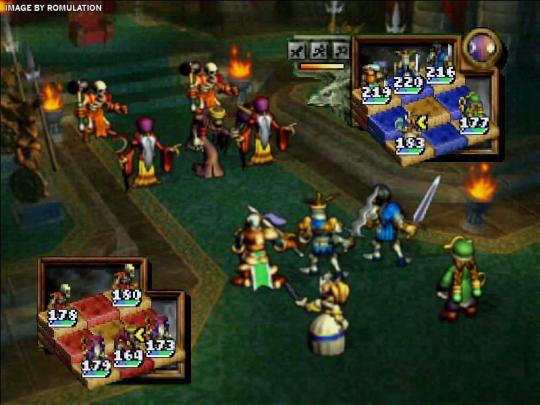
Let's go ahead and bring it back to the present day. I never actually stopped working on content, I've just put all of that time into developing a game of my own design. In that time, I've gone through multiple iterations of a game that has grown far beyond its original aspirations as well as its design as an Ogre Battle TTRPG into something I'm excited to call my own. The project now goes by the name Celestial Solstice and is, more-or-less, done. It's really hard for me to describe the game's focus, but let me try to lay out what makes it special:
A truly balanced pillar trio: The game is built to make every theoretical playstyle a viable path toward advancement. Battle, exploration, and social content all hold the capacity for meaningful advancement.
A game of procedures: Taking a note from the mechanical procedures of older TTRPGs and select board games, Celestial Solstice uses closed, ordered feedback loops to organize the gameplay experience. All three gameplay pillars get their own unique style of play which is supported with character options.
No character limits: There are a massive amount of character options for people who love building characters. A three-tier job system with a total of 6 tier 1 jobs, 12 tier 2 jobs, and 12 tier 3 jobs means you can mix and match to create your own unique class. There are no character levels, and players instead buy character upgrades using EXP they earn for overcoming challenges. These EXP can be used to upgrade attributes, buy new features, and acquire and improve skills.
Gathering & Crafting: A large amount of focus on gone into incorporating gathering of raw materials and the crafting of those raw materials into usable items into the game. Forestry pairs with woodworking, herbalism with alchemy, mining with blacksmithing, and skinning with leatherworking to give players a wide assortment of options whether they want to do some crafting on the side or dedicate their entire character to the concept. There's also a system for enchanting items with magical effects which KINDA counts as crafting, right?
Control an army: The game is designed from the ground up for the recruitment of NPCs as well as the hiring of retainers, mercenaries, and employees. Recruit up to 50 characters which can participate in the game just like PCs do, going on adventures, gaining EXP, and improving over time. There's also a whole player-owned base mechanic which acts as the home for your ever-growing army.
A unique, fast-paced battle system: The battle system is modeled after the unit grid based system found in Ogre Battle 64. Emphasis is placed on battles that resolve quickly to prevent burnout yet allow players to roll lots of dice and make strategic decisions that matter. In this system, strategic unit placement is just as important as good dice rolls.
It's a point crawl system!
Random generation tables EVERYWHERE!
And honestly much more!

This are no plans for this to be a commercial project, at least not any time soon, but with that said it is technically a playable, complete game that is being iterated and improved upon over time. At the end of the day, I'm writing this post as a stupidly long-winded way to ask: Would anyone here be interested in seeing this blog turn into something dedicated to my personal TTRPG system? It's never going to be a 5e blog again, but I'd hate to let it wither away to nothing after such a long history. If so I'll start making posts describing the mechanics of my system and giving behind the scenes looks at how and why some of the design decisions were made, but I understand if people aren't interested in following a project they can't incorporate into the own games. Lemme know, cause I like you guys and would love to share this project that has become so close to me, but I get it, it is what it is lol.
Thanks for reading, and good gaming regardless!
- Forge
19 notes
·
View notes
Text

MCDM’s first original game, a new Heroic Fantasy RPG from the folks who brought you;
Strongholds & Followers
Kingdoms & Warfare
The Illrigger
The Beastheart
The Talent
Flee, Mortals!
Where Evil Lives
Comes a brand new game, built from the ground up to give you a better system for running a better game.
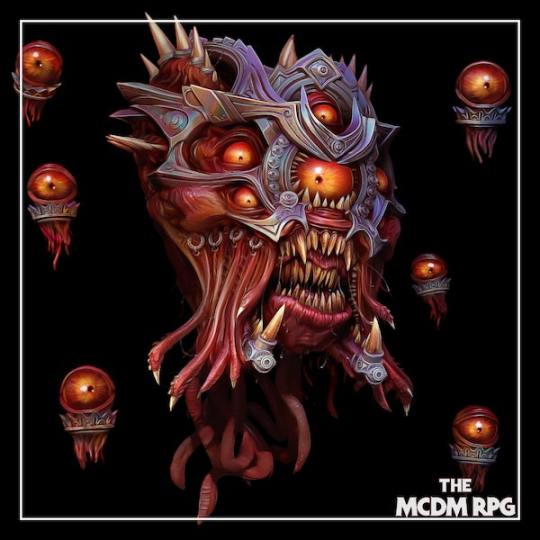

Xorannox, The Tyract Lord Syuul

A Fantasy RPG where your character starts, at level 1, already a hero. Maybe even locally famous! You might meet in a tavern, or start in the middle of the action!
Whether you’re a group of local heroes sent to investigate mysterious goings-on in the nearby haunted wood, or famous mercenaries plotting and scheming in the big city, the MCDM RPG makes building adventures and fighting monsters fun.
Basically, any adventure or story you’re running in your current Fantasy RPG, you can do that in this game. Just, in a more straightforward and fun way, unburdened by sacred cows from the 1970s.

You can absolutely run epic games with heroes exploring dungeons, but this game is not about dungeoncrawling. You don’t track torches or rations or worry about running out of light.
You can plunge, heedless of danger, into a dark and haunted forest, but this game is not about exploration. No hexes to explore.
By focusing on the core fantasy of epic heroes fighting monsters and tyranny, we think we can deliver a better experience for your friends and your table.

Fighting monsters in this game is a dynamic, action-oriented blast. Heroes and monsters often have abilities that knock their opponents into walls, through doors, into each other.
Every hero has a small array of cool, thematic abilities they can use every round. You gain resources in this game as you play, so battles get more epic as they go. No slog.
The game uses 2d6, plus a handful of d4s and d8s. When you attack, you roll 2d6, add one of your attributes, and that is how much damage you do. Your attack roll IS your damage roll.
You cannot miss. No more wasted turns, no more burning resources on spells only for your target to “save.”
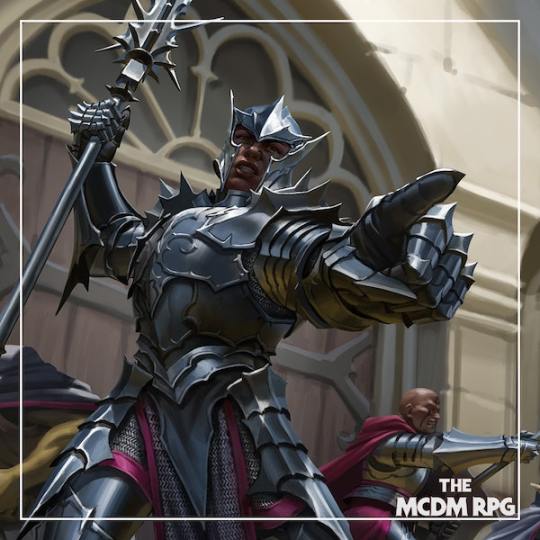

Lady Morgant Lord Saxton

We love fighting monsters! But there’s more to the game than that!
Certain NPCs can be negotiated with to get them to change their allegiance or reconsider their actions. (Technically, ANY npc can be negotiated with but there’s usually only one per adventure) These NPCs have stats like Patience and Interest.
We also plan on rules for Research & Crafting to let players unlock ancient secrets and build wonderous marvels.
We have ideas for how to make language fluency relevant, better rules for wealth, renown. But it’s unknown how much of that we can fit in a 400 page rulebook.


full resolution - What is this game?
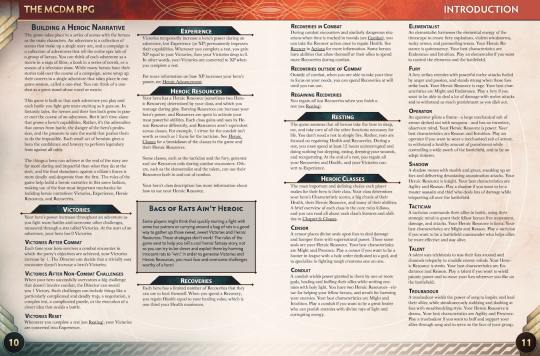
full resolution - Building A Heroic Narrative
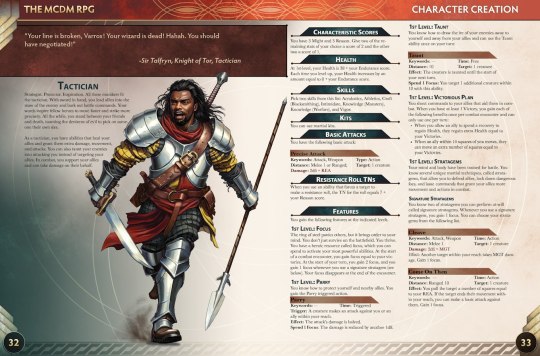
full resolution - Tactician
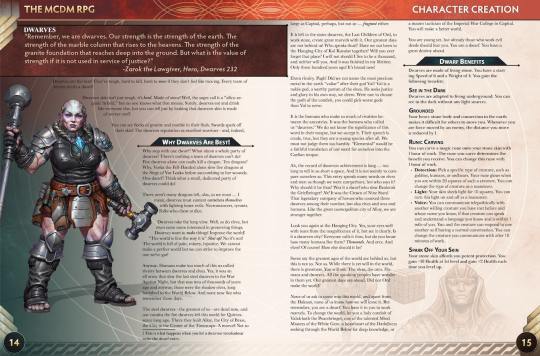
full resolution - Dwarves
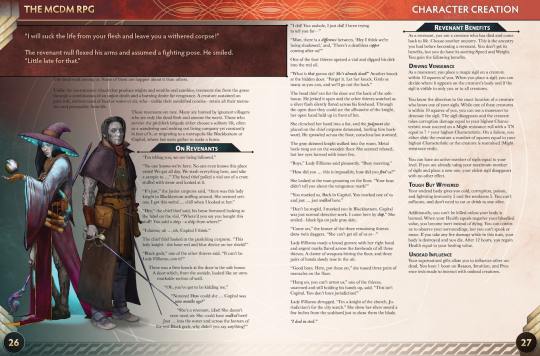
full resolution - Revenants
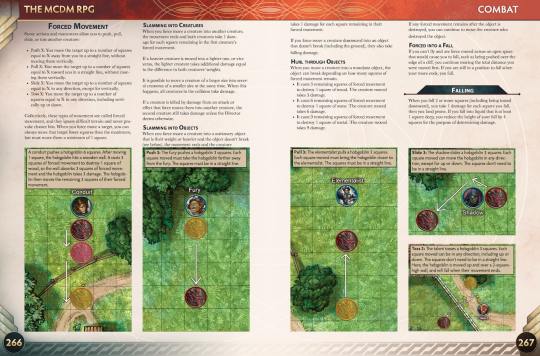
full resolution - Forced Movement
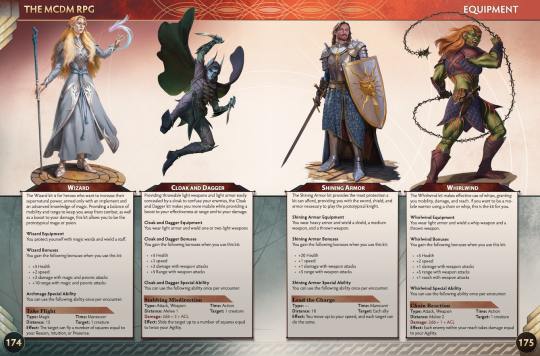
full resolution - Kits
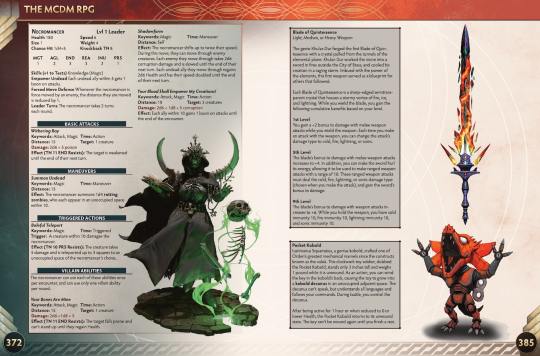
full resolution - Necromancer

We are funding two books!
Heroes Basically, The Rulebook. Approximately 400 pages of rules for making characters, character customization, advancement. There’ll be ancestries (classic and new!), classes, skills, rules for combat, negotiation, research & crafting, and more!
We really like customizing characters and giving players lots of options. Even two heroes of the same class and ancestry can be very different in this game.
Monsters A monster book! Basically, Flee, Mortals! without the Villain Parties or Environments. MOST of the monsters in our 5E monster book, plus all the stuff we had to cut, and a bunch of new stuff!
You’ll also get rules for building balanced (or deliberately unbalanced depending on how much trouble your players have gotten into) encounters.
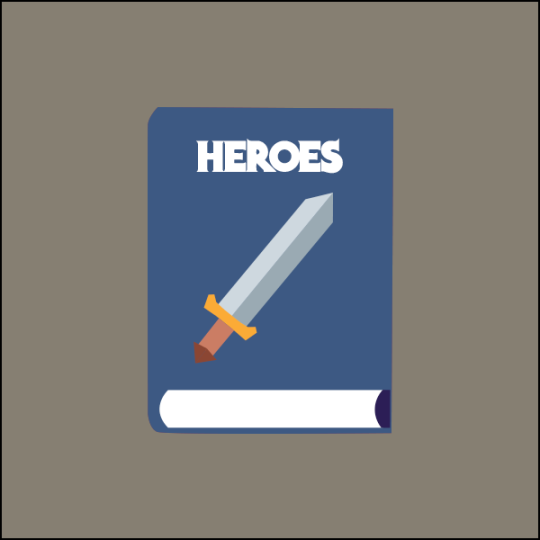
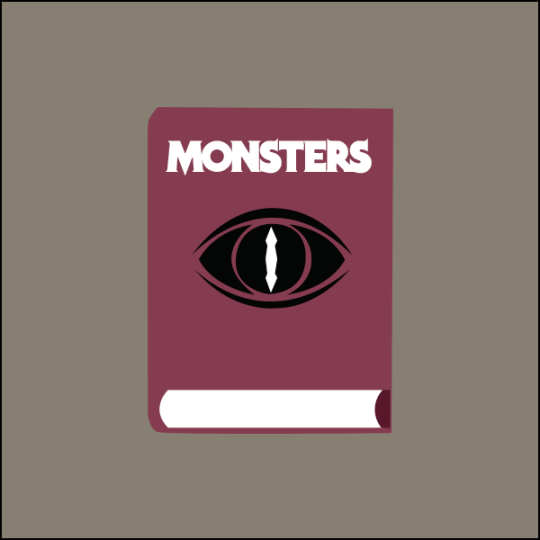

We’ve been testing and developing this game internally for almost a year now, but that was just the folks at the office and our friends. The first packet went to our Contract Testers back in August and have been pounding on it ever since.
The game is already working and it’s already fun! For the next 18 months we’ll be adding more classes, ancestries, progression, customization, and rewards.
We take testing very seriously. We want to make books that are fun to read, full of great ideas for your world and your game, and fun to play and that takes time. Polish, iteration, and lots of testing.
You do not need to take our work for it, come to the Discord and talk to them directly, or join a future playtest.

We think we can get these two PDFs finished by June of 2025, but we don’t think you’ll have to wait that long to play it.
If things go well, we intend to get you, our backers, a playtest packet sometime next year, hopefully by Q2 2024.
We intend to publish this game under an open license, probably something like the Shadowdark license, because we want you, and anyone who wants to, to make, share, publish their own work using these rules and set in this world.
We hope, by the time the PDF exists, folks will not only have been playing this game for months, they’ll be making, sharing, selling their own original works using this material.
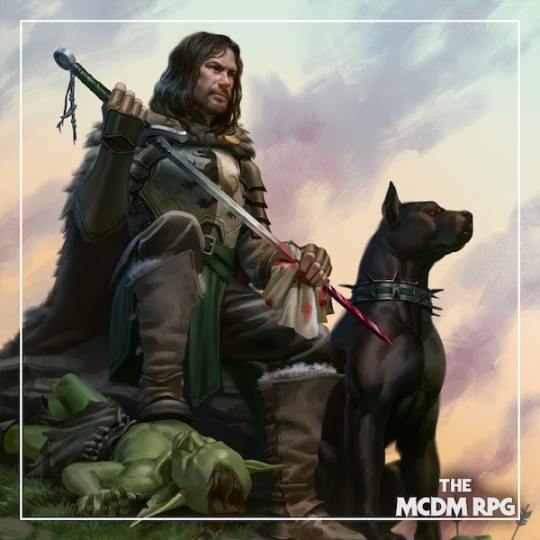

Lord Kenway Pinna

Backerkit campaign ends: Jan 5, 2024 at 8:01am GMT
Website: [MCDM Productions] [facebook] [twitter] [instagram] [youtube] [discord]
56 notes
·
View notes
Text
Since posting the results of the healing spell poll, something's been bugging me: would D&D settings besides Dark Sun develop CPR?
Cardiopulmonary resuscitation requires an understanding of cardiology and the pulmonary system. These are not givens. To understand how the body works, you need to practice dissection. There is a taboo against handling and dismembering corpses in almost every culture; it took other pressures in favor of scientific advancement to get past these taboos and to a basis for medicine beyond basic pharmacology ("this plant does this to people!"). Even the germ theory of disease took centuries to gain sway after its inception.
This is partially because of how humans treat tradition and partially other biases.
But if you have a competing mechanism for healing which doesn't require elaborate bodies of knowledge, would you ever develop those bodies of knowledge? We're not talking isolated scholars with obsessions or hyperfixations, we're talking societies creating repositories of knowledge and establishments that support the creation of further knowledge.
To put it another way: you can't make a Heal/Medicine check to use CPR if the only record of CPR is in a dusty tome written by someone called "the Mad" 300 years before you were born, which is now either shelved in some collector's library of rare books or else at the bottom of a dungeon, in either case forgotten. The knowledge has to be transmitted. And if you have revivify available, it's not going to be.
"But revivify is a powerful spell! It's hardly common!"
In which universe are you playing?
Greyhawk is the standard for magic levels in D&D, as it has been since it got adopted as the standard setting. It's not low-magic by any stretch of the imagination. 5th-level characters are all over, so revivify should be fairly common.
Forgotten Realms has always been high magic and it's the current standard setting. (5e players are probably unfamiliar with the setting's earned description in earlier editions: "Pick up a rock: +2 AC! Pick up another rock: +1 on saves vs. poison!") You can expect revivify to be in wide use in the Realms. The same should be true of any other setting in Toril (Al-Qadim, Kara-Tur, Maztica, etc.).
Eberron was supposed to be low-level but magic-pervasive, which didn't quite work out. Canonically, high-level characters are few and far between; mechanically, there's a lot of Eberron-specific material that requires high-level play. Revivify could easily appear on a Lesser Mark of Healing, given what else appears on Lesser marks. The Lesser dragonmarks aren't that rare, either; each of the guilds/houses is built around their use.
This raises other questions about how the presence of magic might dampen (or enhance) the progress of knowledge in any given field, but I'll leave it at just healing magic. How much would we know and not know about medicine if we could cure diseases and mend wounds through faith in the gods alone?
8 notes
·
View notes
Text
about me — people i’d like to know better.
LAST SONG. Online - TWRP Feat. Tom Cardy & Montaigne. I’ve been a fan of TWRP for a number of years now, as well as loving Tom Cardy’s chaotic energy from when I used to watch his Tiktoks (I’ve since deleted the app as it was a huge time-waster for me), so when I heard that they had collabed for a song I knew it’d be a banger. I’ve had it on repeat since it was released.
FAVORITE COLOR. I really love dark greens, burgundy and warm, autumnal yellows. My bestie also gifted me an Oracle deck for my birthday and I adore the similar colours/ wintry forest palette that it has. I think it’s been a big inspiration, even if the cards keep calling me out!
CURRENTLY READING. I’ve been slowly plodding my way through The Way of Kings by Brandon Sanderson; I’m enjoying it but just have not had the spoons/ attention span to dedicate to reading. I tend to gravitate towards audiobooks nowadays, which I listen to when I’m driving.
The most recent books I’ve finished have been audiobooks during my commutes- I’m Glad My Mom Died by Jeanette McCurdy, and Cultish: The Language of Fanaticism by Amanda Montell.
CURRENTLY WATCHING. I’m watching more YouTube at the moment than serialized shows. One of my favourite YouTube channels, Lore Dump, has started a series on the Yakuza games and I’m really enjoying the chaotic energy that Chase brings to the host seat.
The idea behind the channel is that one of the three hosts does a full plot recap of a game franchise that the other two have not played or aren’t familiar with. They’re long form videos that you can treat like podcasts or put on in the background (I use them for my commute to/ from work), and they’ve covered series like Bioshock, Metal Gear, Red Dead Redemption and Batman. They also did a 12 video series on Kingdom Hearts that is just under 30 hours long, which I highly recommend if you’re into long haul deep dives!
I love it because the hosts clearly love the series they’re talking about dearly, and hearing the others gradually getting swept up in the excitement of the narratives is really entertaining.
SWEET, SAVORY, OR SPICY? I’m a sucker for savoury foods, but I do get the occasional craving for sweet foods. Sadly I can’t tolerate spicy foods like I used to :<
RELATIONSHIP STATUS. Happily married for the past eight (nearly nine) years! My partner and I married young, and it’s hard to believe it’s been so long already. I adore him so much and it’s been a joy to grow alongside him.
LAST THING YOU GOOGLED. “Do they make scuba suits for dogs”. This was for our modern day TTRPG game, using the ‘Everyday Heroes’ module for D&D 5e.
The game is set in Australia in the 2070s after a catastrophic rise in sea levels, and because we’re playing in our home state, we’ve been able to use google maps and a lot of real-world resources in the game which has been super fun. We’ve even made an interactive map to keep track of important locations.
In our last session, we found information that points to us needing to go to locations under the new sealine and joked about taking our rangers’ sniffer dog along on the dive.
The answer we got is yes, there absolutely are diving suits for dogs.
CURRENT OBSESSION. I’ve been getting back into playing mobile games in my downtime! A few long-time favourites of mine are below- bear in mind that I’m on Android so these may not be available on iOS if you want to check them out.
The main one I’ve been playing is called Luna Story; it’s the first in a series of 3 apps that are nonogram-based games. Using a grid and a sequence of numbers, you fill in the grid to create pictures. I’ve had Luna Story installed on my phone for years and have been sporadically playing it, but I’ve recently dived into it again and am playing it before bed, on my lunch break and even when I wake up some mornings. The grid sizes range from beginner (5x5) to advanced (20 x 20) and uses super cute pixel art.
The other is called My Oasis, which is an idle clicker game where you progressively grow an island with animals. It’s got lots of positive little messages in it, like the abilities to buff your clicking being called virtues- like ‘compassion’, ‘selflessness’, etc. The animals I’ve chosen for my island are all favourites of the people I love- a fox for my little sister, a red panda for my husband, giraffe for my mum- even a racoon for myself. The animals can speak via bubbles with encouraging messages, and sing to you- you can sing back to them with a little keyboard at the bottom of the screen. Super cute, if a little clunky at times.

Tagged By: Thank you @why-raven for the tag! ♥
Tagging: @zenmai--jikake--no--komoriuta, @gatheredfates, @riftdancing, @ishgard, @this-is-ris, @thefreelanceangel and anyone else who wants to do this! ♥
6 notes
·
View notes
Text
Trouble In Tinscrap
A ragtag group of kids go trick or treating and meet an eccentric inventor who wants to show them the world of tomorrow!
The world of tomorrow is bad actually.
youtube
0 notes
Note
hello. do you have any recommendations for ttrpgs that enable robust roleplay? my friends want to get back into dnd after not playing for a few years but i think it would be fun to branch out, espscially considering how they like to focus more on character & story than combat encounters. thanks in advance!
The best one for like, roleplay and storytelling IMO is probably Numenera, the game has this really really good system in which players have stat pools instead of numeric bonuses, that serves both as their health, and as a kind of Stamina bar that they can use to apply Effort to a task to make it easier.
So what this translates to is if you want your character to accomplish some physically or mentally arduous task, they can do it and there's a gameplay mechanic around like, "And Nemo the Glaive does indeed climb that wall, her muscles are ragged, her fingers are torn up and bleeding, she collapses to catch her breath" because it wasn't just a close roll, it was one in which you spent some of your Brawn/Speed to do so - in fact Numenera features this really smart thing where if you fail a roll, as long as the GM doesn't specifically say "yeah you can't try again", you can immediately reroll but you have to spend Effort. So that can even feed back into the story of like, "Nemo starts to climb but she slips, hits her side against the rock face, gulping up the air that just got pushed out of her lungs she tightens her grip with her one remaining hand and swings around to get more stable footing, and tries again"
It also features this really ingenious thing where the players always roll the dice - the players (almost) always roll a D20 - and what they have to roll is a target number based on what the GM says the task's difficulty is (1-10) - very rarely with math after the fact. So unlike say, 5E/Pathfinder/etc there's no "Whoops we got caught in the moment and forgot what half the mechanics and dice rolls are here", you know it's Always gonna be a D20 and it's Always gonna be what the dice says, without adding your stat bonus and your proficiency modifier and whoops you still have guidance I forgor so add a D4 and-
The other thing that I really like about Numenera (The other game I'm gonna recommend does this too), is it has a THICK rulebook (418 pages!!) that contains short stories, lore snippets, Numenera also specifically has these long segments about each nation and tribe in their map, their culture, cities, who each nation beefs with and why, all contained in the Core Rulebook so you can get a sense for the world without needing to find a bunch of supplementary text.
As an aside - you mention not wanting to just do combat. One other thing Numenera does that I really like is that it's bestiary features a wide list of creatures that have motivations and thoughts other then "Eat adventurer, roll initiative" - for example, one creature in it just wants to eat Numenera and gain their power, so players with sufficient observation skills and enough self control to not immediately attack can figure out it just wants to eat that weird cube in your pack, and you weren't planning to use it anyway, and resolve the encounter that way
Lorewise, Numenera is a setting in which civilization has risen and fallen something like 8 previous times, sometimes reaching the level of galactic spacetravel, sometimes reaching the point of being able to build Dyson Spheres and new worlds, and sometimes getting beyond even that. All contained on a feudal alt-earth with a fantasy flair to it. It kind of takes the "Sufficient enough technology is indistinguishable from magic" phrase and builds a whole setting based off of it. Players delve into ancient vaults, ruins, and ships, and its obvious its like, an ancient spaceship, a forgotten lab, and so on, but do the characters know that? The world is full of mysterious magical artifacts except the magical artifact is like, a vial of liquid that if poured on you hardens and becomes steel, a mysterious box and sphere and the sphere you can place somewhere, and view what the sphere sees from the box anywhere on the world, the one where they just straight up describe a sniper rifle as if its an esoteric staff,
This ask got kind of long so the other one, Shadowrun, is below the cut ⬇
The other one is, way more mechanically complex, but I'm a bit of an evangelist for it, is Shadowrun. I can't speak to how 6th edition is (I'm sorry Catalyst game labs I'm sorry I bought like 10 Shadowrun 5 sourcebooks and I'm not ready to let them go yet), but in 5th edition the game has this insane level of character customization to where I'd strongly recommend downloading a program to help you (Like Chummer5, I think some people back when I played it at a game store used Hero Forge somehow. I saw another one called OMAE) - point is, you're gonna be doing a lot of math making a Shadowrun character, and spending a lot of time juggling priority tables, weighing minor differences in stats for cars and commlinks, optimizing your starting perks and flaws, etc.
Once you get out of character customization though, all you're really rolling is an insane number of D6s and counting the ones that are 5 and 6 (The rulebook will call them Hits), based on a combination of your stat, the skill being rolled, and any specializations you have and gear bonuses you get. The game can get pretty complex if like, you're playing as a hacker and using the erratas that add new stuff for hackers, but a solid 80% of that is gonna be the GM doing the lifting, so they get the choice on how crazy they want to get with the rolling and rules.
So why would I say "Oh Shadowrun is good for that" if its way more number and dice crunchy then Numenera?
Well, the first reason is that Shadowrun has no character classes, there's a few stat caps based on if you're playing as an Elf or Troll or Orc or something instead of a human, but beyond that you can take your starting character and go anywhere with it. Don't like that bards in DnD still have a wide list of combat things they can do? Want to play someone with the charisma skills and they immediately eat SHIT the second that bouncer gets tired of them and goes to toss them in the street? Well you're in charge buddy! Want to make a wizard but instead of being smart, you want to be good at physical tasks so when spells don't cut it he pulls out his glock and starts casting bullet? You KNOW you can do that!! Hell, there's even things that can raise those aforementioned stat caps so that if you want to play as The Scholarly Troll you can do that
The other reason Shadowrun can be good for that is that the Shadowrun core rule book is *502* fuckin pages, and that's not all mechanics and tables and rules and example maps. Shadowrun 5's CRB (And every single errata) is full of short stories, forum style messages from people in universe discussing the merits (or demerits) of gear, setting the stage for the world and the megacorps that run it, and so on.
Lorewise, Shadowrun is set on earth - but specifically an earth where in 2012 magic returned, and violently. Dragons flew around and set stuff on fire, wizards and warlocks immediately awoke to their abilities, oftentimes without the ability to fully control them, the fae, and so on. Flash forward to the 2050s, all of that still exists, but now it's the cyberpunk future on top of it. Dragons run a couple of the big 10 megacorps. Your elf or orc ranger can get cybernetics, the spirit shaman can be the spirit shaman of the mysterious sewer sludge, and so on. Its the big classic cyberpunk setting that, well, isn't called Cyberpunk
16 notes
·
View notes
Text
Undecided about D&D 5.5 and the 2024 rules



Pros:
Weapon Mastery
Cunning Strike
stat boosts and skills moving from Species to Backgrounds
the PHB rules glossary and the DMG toolkit (for ease of use)
origin feats, and general feats giving +1 to a stat
easier to homebrew player-facing rules (because feats and subclasses are more streamlined)
some big changes, some minor tweaks
Cons:
power creep (full assessment pending until the MM comes out)
uneven power creep
stealth makes no sense
they fully bailed on the skill system
strains suspension of disbelief even more
less support for homebrewed monsters
some big changes, some minor tweaks
The CR system needs playtesting with the new Monster Manual, so assessment pending. We're probably gonna see much more dangerous monsters: Cure Wounds straight up doubled the hp it heals, and healing in general is a lot more generous. I don't know if that bloat was necessary, or motivated by anything other than "players can do MOAR damage now, buy our new books to be COOLER!", followed by a domino effect.
At this point, I'm torn between incorporating a few 5.5 rules to 5e, or a few 5e rules to 5.5, or whole other subsystems to either (I'm looking at the skill system of Level Up a.k.a. Advanced 5th Edition, it's interesting), or abandoning D&D altogether (because I'm tired, not because it's that bad). But I'm pretty sure I won't adopt 5.5 as is.
Assessment pending.
62 notes
·
View notes